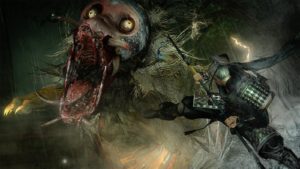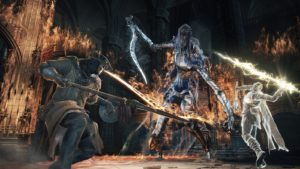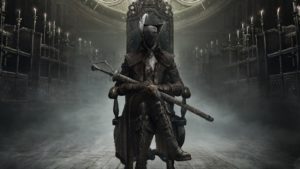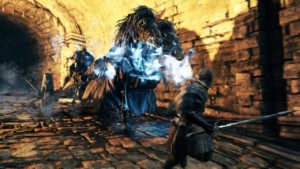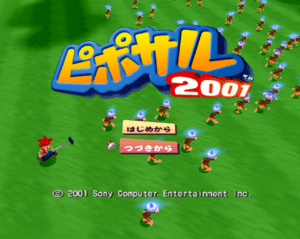I recently began replaying Dark Souls, this time on PS4 with the remastered edition. Having played a ton of Soulsborne and Souls-like games in the past few years, it’s fascinating going back to the game which really popularized the modern action game formula. I’m definitely enjoying myself, but that got me thinking about all the things I love and hate about this franchise and the subgenre it spawned… and wouldn’t you know it, I have a series on this blog which is about just that! So without further ado, here’s what I love and hate about the original Dark Souls!
Love
- Amazing World Design – This is arguably the best part of Dark Souls, where it really shines and is still unmatched, even by its successors. I’m going to split this into a couple parts to cover it more thoroughly:
- Dark Souls‘ world is designed sort of like layer cake. Each new area is connected to the others in an organic way, and it isn’t uncommon to be exploring and to catch glimpses of other areas that you will soon be exploring or to discover a surprising shortcut to an area you previously visited (which is extra important because fast travel is unavailable for most of the game, and even then only in a limited capacity). Furthermore, the areas all stack on top of each other vertically, a very unique approach to an open world which is rarely attempted. The unique design with the shortcuts littered throughout give the entire world map a memorable interconnectedness that sticks with you long after your journey is complete.
- The game is designed in a very non-linear fashion. There is an intended path for newer players which is evidenced by the difficulty of the enemies in each area, but there is technically nothing stopping players from risking going off this intended path into much more challenging areas for their level. In fact, the loot that you can acquire for doing so might make the challenge worthwhile, especially for veteran players. Furthermore, the game also has an optional starting item, the Master Key, for experienced players which makes the early game even more non-linear as it allows you to explore these higher-level challenges much sooner. To make this even better, the game actually has some special rewards for breaking the intended path, such as (SPOILER ALERT):
- If you kill the sunlight maggots early enough, you will save Solaire of Astora from a tragic fate and allow him to be summoned for the final boss battle.
- If you beat the Artorias of the Abyss DLC (end-game content in terms of difficulty, so that’s no light feat) before fighting Sif, she will actually remember the player but fight to defend her master’s honour anyway, giving the fight an even more melancholy air to it.
- The vertical open world design even has thematic significance, as the homes of the (questionably moral) gods of light are found as you ascend the layer cake. In contrast, the darkest places are found as you descend, all the way down to the lowest point of the world in Ash Lake, where humanity itself and the Dark Soul was found. Considering that environmental storytelling is a crucial method in which the game’s narrative is conveyed, this thematic significance is particularly brilliant.
- Unique Character Designs – In addition to the amazing world design, FromSoftware also really nailed the art designs for the different characters and bosses in this game. This includes the NPCs, such as the instantly iconic designs of Solaire of Astora and Siegmeyer of Catarina. The bosses are also incredibly creative and have elements meant to symbolize their characters. Rather than just having a dragon, instead we get the Gaping Dragon, which has turned itself into a huge maw in order to consume more. Or what about Gravelord Nito, a being made up of piles of bones and whispy darkness. Hell, even extremely underwhelming bosses, such as Pinwheel, have incredibly well-thought out designs – in his case, he wears three masks because he’s trying to resurrect his dead wife and child. FromSoftware just always puts this really creative spin on their creatures and it’s part of the fun of discovering what sort of twisted abomination they’re going to throw at you next.
- Build Freedom is Insane – Perhaps the coolest thing about the Souls series in general is just how much freedom the player gets in determining their character build. You get two slots per hand, plus two magic rings and a handful of item slots to use however you see fit. You can run all manner of swords (short, long, greatswords, freaking ultra greatswords), axes, spears, bows, shields and various other exotic weapons, not to mention three varieties of magic with their own lengthy spell lists. Oh and did I mention that all of these weapons can be upgraded with elemental properties which wildly change their damage output? Hell, if you’re insane, you can even choose to run around punching everything to death. And that’s just the weapon options, you’ve also got tons of armour sets (from light, medium and heavy) and your stat distributions which can complement any playstyle, from clerics, to tanks, to melee fighters. Basically, if you can think it, it can be done and you can probably make it work. I like to play the melee glass cannon – minimal HP investment, but very high stamina and strength, running around with a claymore for heavy damage output. The way I see it, if I’m getting hit by more than a couple enemy attacks, I deserve to be killed.
- Surprisingly Rich Story Told in an Unconventional Way – The Souls games are very unique for the manner in which they tell their stories. Rather than conveying narrative directly to the player, the story is told through the environment and item descriptions, which encourages the player to piece the story together themselves. While it is possible to entirely miss the point of everything that happens in the game because of this, it actually makes the game significantly more engaging and rewarding. Even then, the base mythology of the game is also very interesting and makes for a compellingly, strikingly bleak world.
- Resource Management – I know that Demon’s Souls was the basis for this idea, but Dark Souls really popularized the notion of strategic stamina regeneration and healing in modern action games. FromSoftware struck a perfect balance between the game’s speed and the stamina regeneration, making it feel like an essential part of the game rather than a burden on the player.
- Some Absolutely Amazing Bosses – The Souls games are renowned for their bosses, and Dark Souls has some of the biggest standouts in the whole series. So with that in mind, I’m going to shoutout some of the bosses which deserve special praise:
- Artorias the Abysswalker is probably the funnest boss in the game. The funnest bosses in Souls games are often built off of Artorias’ foundation – a large, single warrior duelling you with relentless, heavy attacks, leaving just enough openings to sneak in a hit if you’re skilled. Every game in this franchise features at least one boss which is built in the mould of Artorias, and considering that they’re almost always top-tier bosses, it should really show you just how good Artorias is. The nice thing about these kinds of duels is that they don’t rely on gimmicks exclusive to the boss battle, rather you’re testing your skill with the game’s combat system.
- Black Dragon Kalameet is one of the funnest dragon battles in the whole series, posing an exceptional challenge to the player while remaining totally fair. A lot of bosses this early into the Souls series feel less refined than later entries, but Kalameet is still a standout boss to this day.
- Ornstein and Smough are probably the most iconic boss duo in the entire franchise; I was aware of their reputation years before I even faced them for the first time. The fight itself is exceptionally difficult, but manageable if you focus them down skilfully. They’re also probably the best gank fight in the series, with their differing speeds and attack patterns not feeling like utter bullshit to fight. That feeling when you finally defeat Ornstein and Smough is one of the most satisfying moments in the entire franchise.
- I also want to give some smaller shoutouts to Great Grey Wolf Sif, Chaos Witch Quelaag, the Bell Gargoyles and the Sanctuary Guardian.
- Backstabs Are Too Good – I like backstabs in this game, especially for the weaker enemies when you’re a low level. However, they are a little too easy to pull off in this game due to the speed of the game and the way enemies attack. It becomes less of an issue later on in the game when there are less humanoid enemies, but if a player relies too much on backstabs then those later sections of the game are going to be way more painful. I feel like later games in the series handled backstabs a little better and made them harder to pull off, but they are a bit too easy here.
Hate
- Really Obtuse Mechanics – It’s one thing to make the player intuit the game’s story themselves, but it’s entirely another thing to force them to understand a myriad of unexplained game mechanics. Some stuff, like equipment load percentages, are just not conveyed and make playing the game more of a chore, but there are other mechanics which are significantly worse:
- Hollowing and kindling is a mechanic that I still don’t understand properly in Dark Souls. In this game, you use the Humanity item to gain humanity which apparently gives you some statistical bonuses (and scales with certain weapon types) the more you have. Humanity can be spent to reverse hollowing and to kindle bonfires in order to have more estus flask uses. None of this is explained to the player at all, particularly the stat-bonuses. Considering that humanity is a fairly rare resource, you become hollow upon death and can lose all of your “liquid” humanity if you don’t retrieve lost souls, it’s like the game penalizes you for using it. As a result, I usually play the Souls games in a hollowed state 99% of the time, because I hate using finite resources on the off-chance I’ll need them later. Hollowing is supposed to represent despair and growing apathy and I think that later games in the series conveyed that idea far clearer than Dark Souls.
- Covenants can be really confusing and don’t have as many benefits or consequences as you would hope. They basically just encourage some roleplay and online interaction, but the feature isn’t very well fleshed out, nor is there much reason to feel devoted to your covenant.
- Weapon upgrades are a HUGE pain in the ass, which is particularly unfortunate since I’d argue that it’s the most important aspect to keeping up with the game’s difficulty curve (try facing off against the Bell Gargoyles with a +1 or +2 weapon vs a +10 weapon, the difference is night and day). In order to upgrade your weapons, you need to collect titanite shards and require larger shards as the weapon is upgraded higher – okay, that’s fair enough. However, Dark Souls takes it to a stupid level from there. Let’s say you want to add elemental damage to your weapon. First, you need to find an smithing ember, which are hidden throughout the world. Then you have to find the blacksmith who can actually use that ember (did I mention that there are 4 different blacksmiths scattered throughout the world?), and then give it to them. AND THEN you need to have special types of coloured titanite which drop in specific areas to actually upgrade some of these weapons (but not all of them, because that would just be too complicated apparently). Even then, you have to take stat scaling into account, which is different for each weapon and changes when you add elemental damage, potentially making the weapon worse despite being “upgraded”. And that’s not even including special weapons, although at least these are pretty simple, requiring only twinkling titanite, dragon scales or demon titanite to upgrade (these are all very rare items though). Weapon upgrades are just a huge pain in the ass to manage in Dark Souls, and were in serious need of streamlining.
- NPC Questlines Are Easy to Miss – Some of the most compelling stories told in Dark Souls are done through interactions with NPCs. Characters like Solaire of Astora and Siegmeyer of Catarina are unforgettably charming and compelling as you follow their journey through the world, and each questline ends in truly heartbreaking fashion if you can see them through. However, NPC questlines are incredibly easy to miss as you explore the world – do something at the wrong time and you could easily never see one of these colourful cast members again. It’s not like the characters give you clear hints where they’re headed next either, they’ll just show up unexpectedly and if you happen to pass their way then lucky you.
- Janky Game Engine – Considering how successful Dark Souls was, it’s easy to forget that FromSoftware was a relatively small studio with a limited budget, and as a result the game has some pretty questionable design at times. Most notoriously, the game was really badly optimized in its initial launch on PS3, Xbox 360 and (especially) PC. The framerate in Blighttown and New Londo in particular was brutal, often dropping into the unacceptable neighbourhood of 10-15fps. The online performance was also very questionable and led to really frustrating moments with invaders lagging all of the place and backstabbing you out of nowhere. Most of these issues have been addressed in the remastered version of the game, but there are still some eccentricities that have been maintained, like the hilariously weightless ragdoll effect on dead enemies.
- 4 Way Dodge Rolling… But Only While Locked On? – Dodging is a key skill in Dark Souls‘ combat, more skillful and rewarding than hiding behind a shield. Normally you can dodge in any direction, but for some reason when you lock onto an enemy this gets restricted to only 4 directions (forward, backward, left, right). I don’t understand this design choice at all because it’s not like encounters play out in a grid-like fashion to make this make sense and I’ve had this system throw me into enemy attacks unintentionally because of how restricted it is. As a result, when you get more skilled at the game you basically have to lock on and off of enemies to get around this arbitrary limitation.
- Bosses Have Limited Movepools and AI – Perhaps owing to the fact that it’s the first game in the series, Dark Souls has a lot of bosses which are very predictable and exploitable due to their limited amount of moves and reactions. For an example of this, check out my low-level takedown of the Stray Demon – if I get behind it, it has only two attacks it can use with limited ways to actually hit me, meaning that I can basically just repeat the same pattern to whittle it down with little danger to myself. There are other examples throughout the game such as the Gaping Dragon which constantly jumps in the air when you get behind it, rinse and repeat. That said, the bosses do improve as you progress, and the DLC bosses are all top-notch. Also, some of the mini-bosses are pathetically exploitable, especially the stationary ones such as the hydra and the zombie dragon (which will just puke poison in front of it uselessly while you wail on it with arrows from far away).
- Some Incredibly Frustrating Moments… – Sometimes Dark Souls is just an utter bastard to the player, with moments you just plain dread in subsequent playthroughs. Trying to fight the Hellkyte Wyvern is one example, as that thing will stunlock you with fire if you even try to approach it. The notorious Anor Londo archers are particularly egregious and there’s basically nothing in the game up unto that point which will have prepared you to face enemies that will knock you off of thin platforms with their arrows. I got stupidly lucky in my original playthrough and got past them on my first try, but in my remastered run I died to them so many times before I figured out a strategy through significant trial and error (basically, run and let them fall to their deaths like idiots). Sen’s Fortress is also a nightmare gauntlet of difficult enemies and traps, while Blighttown’s poisoned lake is just ridiculous (again, I got extremely lucky in my original playthrough and got through all the rickety platforms to the bonfire on my first attempt, in spite of the crap framerate).
- …and Areas That Are Just Not Fun – While the above areas are frustrating, there’s at least some fun and skill to be had in overcoming the challenge. There are other areas though which are just awful, particularly in the latter portion of the game:
- The Tomb of the Giants is stupidly dark and absolutely no fun to navigate as a result. To make matters worse, you’ve got enemies you can’t see firing arrows at you and giant quadrupedal skeletons which will rip huge chunks off of your health bar, all while you’re trying to avoid falling off of a ledge when you can’t see more than a few feet ahead of you. It doesn’t help that there are only a couple items you can equip to slightly illuminate the darkness, which could potentially leave you without a shield to defend yourself. The only nice thing I can say about the Tomb of the Giants is that at least it’s a relatively small area and that the views of Lost Izalith and Ash Lake are gorgeous.
- …speaking of Lost Izalith it, along with its predecessor area the Demon Ruins, is the nadir of this game without question. Perhaps the worst aspect is that the areas are really uninspired, with long stretches of nothing of note (hell, there’s a good 20-30 seconds of flat, featureless terrain to run through every time you want to enter the Demon Ruins). The enemies are copy and pasted all over the place at random and are totally motionless until you aggro them, making this area feel super amateur. Hell, the enemies in this area are often filled with previous bosses the Taurus Demon and Capra Demon, not to mention one notorious section with an enemy which is literally the ass-end of the zombie dragon hastily re-purposed into a new enemy type. Rather than providing a fair challenge, the Taurus Demons and dragon asses don’t even respawn, which transparently signals that the developers knew that they weren’t fun but needed to have some sort of challenge. Capping the whole area off is the hands-down worst boss in the entire franchise, the Bed of Chaos, which is more of an exercise in frustration than anything else and which you will spend more time running from your bonfire to the boss room rather than actually fighting. FromSoftware has stated that they ran out of time and budget with Lost Izalith, and it really shows, even to the point where they included a shortcut that lets you bypass about 80% of it.

